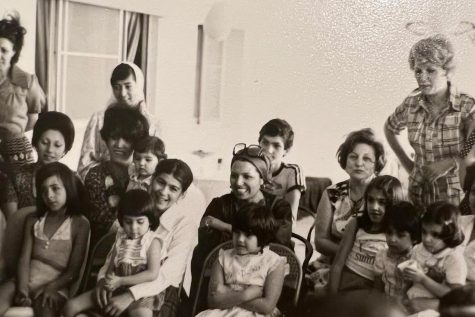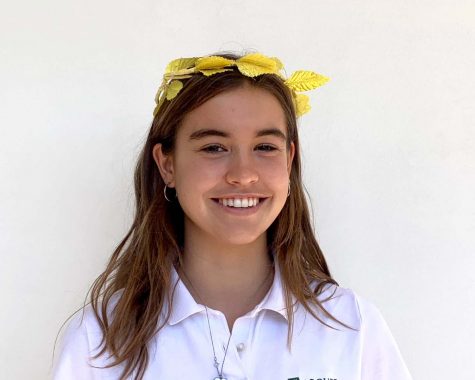Iranian students respond to women’s revolution in Iran, implore community to take action
Photo credit: Delara Tehranchi
Protestors march down a street in Downtown, Los Angeles near Pershing Square. The protest, responding to the death of Mahsa Amini in Iran, took place mid October, and senior Delara Tehranchi took part in the demonstration with her family.
November 6, 2022
Senior Noor Afshar’s family fled Iran four decades ago following the establishment of the Islamic republic, the result of the Iranian revolution. Senior Delara Tehranchi’s family has a similar story. These students are among Iranian community members calling for greater education and action on the uprising in Iran sparked by the death of 22-year-old Mahsa Amini in September.
“I just hope people make noise…To be honest, I’ve seen a lot of silence from people when this is like the biggest war against women probably [in our] time. So if I can educate at least 10 people and that person could do the same for 10 others, I feel like I’ve accomplished something great,” Tehranchi said. “Posting on your social media and spreading the word is all that Iranian women are asking from you, because they just want to make noise and not be silenced and know that they’re not in this fight alone. I really implore everyone to understand that there’s also not two sides of human morality to this. It’s people who want women to have rights in Iran and people who don’t.”
Following the death of Amini, who was killed in the custody of Iran’s morality police for, as the police claim, wearing her head covering too loosely, protests erupted in Iran. Women, men and children took to the streets in demonstrations denouncing the Islamic Republic’s treatment of women; protestors burned hijabs, chanted, shaved their heads and displayed their hair in defiance of the Republic’s rules. These demonstrations were met with further violence, arrests and killings.
“I still have a lot of family there…and it’s amazing because in this time right now, a lot of them are still posting on Instagram and sending videos, which is really dangerous. We’ve been trying to tell them not to, but I think so many women’s voices have been silenced for so long,” Afshar said. “I spend my days waiting with fear and anticipation for social media posts, for petitions to sign and for people who are big public figures such as presidents and dictators, governors [to speak out]. It’s their job and our job as normal human beings and citizens to raise awareness.”
The movement, which has grown exponentially via social media and online platforms documenting the death of Amini and resulting protests, has been countered not only with violence, but also censorship of information. Journalists have been a target of arrests, and the internet was momentarily shut off in Tehran and Kurdistan, blocking virtual information from leaving those areas. Despite these efforts to repress the revolution, protests continued, and Tehranchi identified aspects of the demonstrations that inspire hope.
“We do have faith when we see how many brave women are standing up all across the world, but especially in Iran, like Gen Z are the ones that are sadly getting hurt and getting killed for protesting, but they’re the ones that are demanding action,” Tehranchi said. “And something that also leaves us all hopeful is that in the past when there’s been protests in Iran, it’s been very limited groups, [certain] backgrounds of people in Iran, but for this event, the reason that it’s so pertinent to Iran psych is because every single party — no matter if you’re in the upper class, lower class, liberal, conservative, you’re 100 years old, you’re 12 years old — everyone is coming together in Iran right now and standing up.”
The rebellion has been met with global support. Notable is the number of solidarity protests in the United States and, specifically, in Los Angeles. The city is home to the largest population of Iranians outside of Iran, and thousands have gathered on multiple occasions to show solidarity for Iranians and call for a regime change. Both Afshar and Tehranchi attended multiple protests and recalled, with great emotion, the mid October protest that began at Pershing Square and ended at Los Angeles City Hall.
“To me it was very beautiful, but such a sad moment. [My family, friends and cousins] spent three hours there and none of us wanted to leave because it was as if, once we left, the pride would leave and the power that we felt when we were there would also leave,” Afshar said. “I think that today, the more and more I look at the world, I really do think it is the first time that there’s going to be change. Knowing that and going to protest — having that opportunity to raise my voice at such a young age, which so many women are trying to do in Iran but are getting killed for it — it’s just so beautiful, and it’s so powerful.”
To hear about Tehranchi’s experience at the protests in Los Angeles, listen to the audio clip below.
Freshman Sara Salehi and her family are also Iranian. She called upon national figureheads to lead the charge of speaking up against the injustices.
“The US is such a powerful nation,” Salehi said. “So if you can get Joe Biden or someone empowered to talk about it, that’ll get the rest of the world to wake up to something.”
Afshar described the significance of this revolution from a women’s point of view in contrast to the men in her life.
“I think that the way that even my father and my brothers are looking at it is through a very historical viewpoint of getting rid of the dictator and getting [back] the rights that not only get taken away from women, but also from men,” Afshar said. “The way my mom and I are looking at it — we’re very, very involved. My grandmother, she’s gotten told maybe five times by the morality police themselves, ‘put your hijab on right.’ And she would never put it on right, and thank God nothing ever happened to her. But I would always tell her I would get scared. I would hold her hand one more time before she left for Iran and tell her please put on your hijab. Knowing that a woman has to cover themselves, their hair — such beautiful hair — it’s just ridiculous.”
All three students beseeched the Archer community to stay informed. Eighth grader Charlotte Kamdar, whose grandparents fled Iran in 1978 and settled in Southern California, provided insight into ways students should approach informing themselves and others.

“I hope that they can educate themselves about the history and what’s led up to this … this is a revolution that has been brewing for 44 years. There’s a lot behind this that I feel like people need to know so that they can understand how important this is and how much support is needed,” Kamdar said “Before all this, Iran was such an awesome place… It was really upbeat and fun. And now it’s just totally opposite. And no one ever seeks to learn about that.”
Over a month has passed since the death of Mahsa Amini, and Tehranchi said she hopes to see the Archer community remain knowledgable on and advocates for women’s rights in Iran.
“I hope that everyone can continue to stay educated on this topic because we go to an all girls school, and we care about women empowerment so much. It’s not right when people pick and choose when they want to be activists or when they want to stand up against acts of injustice on humanity,” Tehranchi said. “So, if you have time, I really implore you to understand what’s happening in Iran and contact your local officials and go to the protests and talk to people about what’s happening as well to educate others.”










